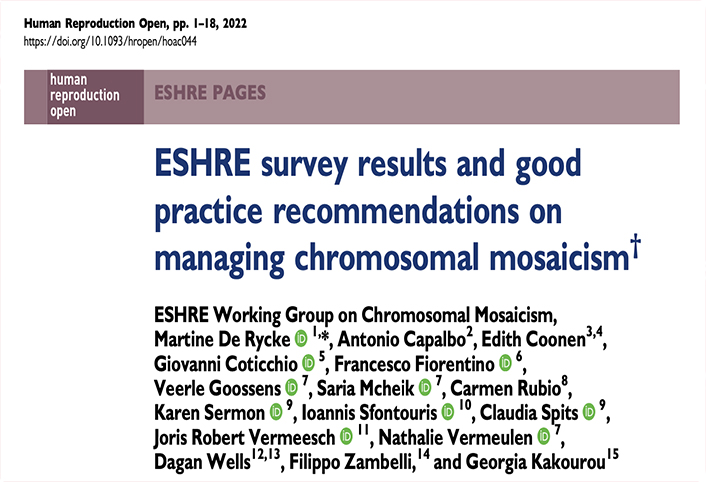
ESHRE Working Group on Chromosomal Mosaicism, Martine De Rycke, Antonio Capalbo, Edith Coonen, Giovanni Coticchio, Francesco Fiorentino, Veerle Goossens, Saria Mcheik, Carmen Rubio, Karen Sermon, Ioannis Sfontouris, Claudia Spits, Joris Robert Vermeesch, Nathalie Vermeulen, Dagan Wells, Filippo Zambelli, Georgia Kakourou
Abstract
STUDY QUESTION
How should ART/preimplantation genetic testing (PGT) centres manage the detection of chromosomal mosaicism following PGT?
SUMMARY ANSWER
Thirty good practice recommendations were formulated that can be used by ART/PGT centres as a basis for their own policy with regards to the management of ‘mosaic’ embryos.
WHAT IS KNOWN ALREADY
The use of comprehensive chromosome screening technologies has provided a variety of data on the incidence of chromosomal mosaicism at the preimplantation stage of development and evidence is accumulating that clarifies the clinical outcomes after transfer of embryos with putative mosaic results, with regards to implantation, miscarriage and live birth rates, and neonatal outcomes.
STUDY DESIGN, SIZE, DURATION
This document was developed according to a predefined methodology for ESHRE good practice recommendations. Recommendations are supported by data from the literature, a large survey evaluating current practice and published guidance documents. The literature search was performed using PubMed and focused on studies published between 2010 and 2022. The survey was performed through a web-based questionnaire distributed to members of the ESHRE special interest groups (SIG) Reproductive Genetics and Embryology, and the ESHRE PGT Consortium members. It included questions on ART and PGT, reporting, embryo transfer policy and follow-up of transfers. The final dataset represents 239 centres.
PARTICIPANTS/MATERIALS, SETTING, METHODS
The working group (WG) included 16 members with expertise on the ART/PGT process and chromosomal mosaicism. The recommendations for clinical practice were formulated based on the expert opinion of the WG, while taking into consideration the published data and results of the survey.
MAIN RESULTS AND THE ROLE OF CHANCE
Eighty percent of centres that biopsy three or more cells report mosaicism, even though only 66.9% of all centres have validated their technology and only 61.8% of these have validated specifically for the calling of chromosomal mosaicism. The criteria for designating mosaicism, reporting and transfer policies vary significantly across the centres replying to the survey. The WG formulated recommendations on how to manage the detection of chromosomal mosaicism in clinical practice, considering validation, risk assessment, designating and reporting mosaicism, embryo transfer policies, prenatal testing and follow-up. Guidance is also provided on the essential elements that should constitute the consent forms and the genetic report, and that should be covered in genetic counselling. As there are several unknowns in chromosomal mosaicism, it is recommended that PGT centres monitor emerging data on the topic and adapt or refine their policy whenever new insights are available from evidence.
LIMITATIONS, REASONS FOR CAUTION
Rather than providing instant standardized advice, the recommendations should help ART/PGT centres in developing their own policy towards the management of putative mosaic embryos in clinical practice.
WIDER IMPLICATIONS OF THE FINDINGS
This document will help facilitate a more knowledge-based approach for dealing with chromosomal mosaicism in different centres. In addition to recommendations for clinical practice, recommendations for future research were formulated. Following up on these will direct research towards existing research gaps with direct translation to clinical practice. Emerging data will help in improving guidance, and a more evidence-based approach of managing chromosomal mosaicism.
STUDY FUNDING/COMPETING INTEREST(S)
The WG received technical support from ESHRE. M.D.R. participated in the EQA special advisory group, outside the submitted work, and is the chair of the PGT WG of the Belgian society for human genetics. D.W. declared receiving salary from Juno Genetics, UK. A.C. is an employee of Igenomix, Italy and C.R. is an employee of Igenomix, Spain. C.S. received a research grant from FWO, Belgium, not related to the submitted work. I.S. declared being a Co-founder of IVFvision Ltd, UK. J.R.V. declared patents related to ‘Methods for haplotyping single-cells’ and ‘Haplotyping and copy number typing using polymorphic variant allelic frequencies’, and being a board member of Preimplantation Genetic Diagnosis International Society (PGDIS) and International Society for Prenatal Diagnosis (ISPD). K.S. reported being Chair-elect of ESHRE. The other authors had nothing to disclose.
DISCLAIMER
This Good Practice Recommendations (GPR) document represents the views of ESHRE, which are the result of consensus between the relevant ESHRE stakeholders and are based on the scientific evidence available at the time of preparation.
ESHRE GPRs should be used for information and educational purposes. They should not be interpreted as setting a standard of care or be deemed inclusive of all proper methods of care, or be exclusive of other methods of care reasonably directed to obtaining the same results. They do not replace the need for application of clinical judgement to each individual presentation, or variations based on locality and facility type.
Furthermore, ESHRE GPRs do not constitute or imply the endorsement, or favouring, of any of the included technologies by ESHRE.
